May 10, 2017
Dahlia graouuuu lavallière and her tutorial
Hello! Would you like a tutorial to get started?! When you see how ready-to-wear brands recycle their patterns from season to season, I think that mastering a few notions of pattern transformation is really something great. It is in this state of mind that I wanted to write my book Apprendre à créer ses patrons. 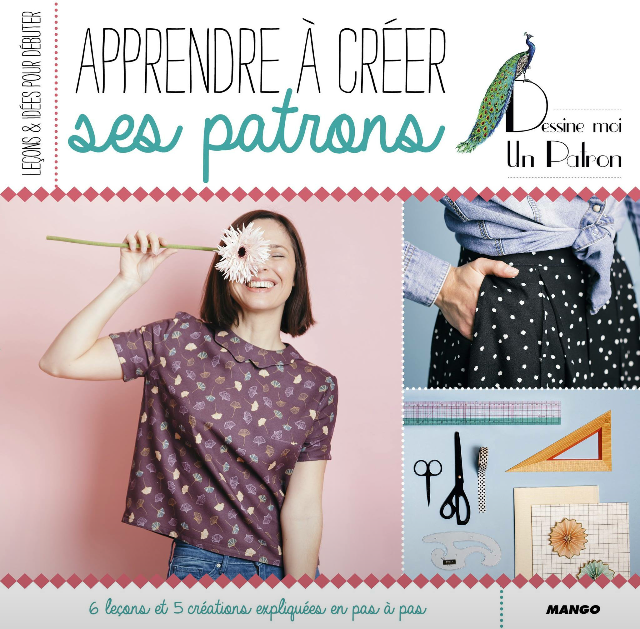 When the Mango publishing house contacted me to write a pattern-making book, I was flattered but also a little terrified. I thought a lot about the angle from which to approach the question. Making pattern-making democratic and fun is really difficult, because the part of building basic patterns remains a very academic step. This is why I chose to highlight the "transformations" that allow you to make your basic pattern BUT ALSO when you want to get started gently, to start from a commercial pattern and personalize it. As an example, I wanted to show you how to transform an "old" pattern from my collections, the Dahlia blouse , to make you a very, very trendy little piece this spring: a pussy-bow blouse WITH a ruffled collar (the double trouble that rocks!). And as the heat rises towards my place, we skip the sleeves and rework the armholes a little (and yes I make you work but you'll see it's so pretty!). And then with this slightly collared model we would quickly get hot otherwise. For this version I also chose to skip the back pleat and I simply gathered it (crazy go!).
When the Mango publishing house contacted me to write a pattern-making book, I was flattered but also a little terrified. I thought a lot about the angle from which to approach the question. Making pattern-making democratic and fun is really difficult, because the part of building basic patterns remains a very academic step. This is why I chose to highlight the "transformations" that allow you to make your basic pattern BUT ALSO when you want to get started gently, to start from a commercial pattern and personalize it. As an example, I wanted to show you how to transform an "old" pattern from my collections, the Dahlia blouse , to make you a very, very trendy little piece this spring: a pussy-bow blouse WITH a ruffled collar (the double trouble that rocks!). And as the heat rises towards my place, we skip the sleeves and rework the armholes a little (and yes I make you work but you'll see it's so pretty!). And then with this slightly collared model we would quickly get hot otherwise. For this version I also chose to skip the back pleat and I simply gathered it (crazy go!). 
 The fabric comes from the brand new online haberdashery Folkandfabric . This is the 3rd fabric I've sewn from them and it's still wonderful! The print is crazy and the slightly "raw" look of the fabric (you'll see it in the close-up) takes the drama out of the animal skin. And then, French fabric, it's still a pleasure. I hope you'll like my blouse as much as I do, personally I'm crazy about it! The tie can be tied in the front, at the back, or gently used as a tie, it's up to you!
The fabric comes from the brand new online haberdashery Folkandfabric . This is the 3rd fabric I've sewn from them and it's still wonderful! The print is crazy and the slightly "raw" look of the fabric (you'll see it in the close-up) takes the drama out of the animal skin. And then, French fabric, it's still a pleasure. I hope you'll like my blouse as much as I do, personally I'm crazy about it! The tie can be tied in the front, at the back, or gently used as a tie, it's up to you! 

 Come on, let's go for the tutorial of this transformed Dahlia: I started by retouching the pattern: I shortened the front and back shoulder line by 4 cm to cut out the armholes (it's up to you, of course I wanted to cut out the armholes), and I re-traced with a gun (for the back I pinned the yoke and the bottom of the back, be careful when taping to overlap the seam allowance). And I extended my collar stand piece by 55 cm (the piece being on the fold you will have a nice lavallière, and you have to cut it x2 on the fold ;) )
Come on, let's go for the tutorial of this transformed Dahlia: I started by retouching the pattern: I shortened the front and back shoulder line by 4 cm to cut out the armholes (it's up to you, of course I wanted to cut out the armholes), and I re-traced with a gun (for the back I pinned the yoke and the bottom of the back, be careful when taping to overlap the seam allowance). And I extended my collar stand piece by 55 cm (the piece being on the fold you will have a nice lavallière, and you have to cut it x2 on the fold ;) ) 


 Back assembly: fold your center back line of the back yoke twice to make the small center back hem (your assembly notch prefigures the "finished" garment, i.e. the hem made).
Back assembly: fold your center back line of the back yoke twice to make the small center back hem (your assembly notch prefigures the "finished" garment, i.e. the hem made). 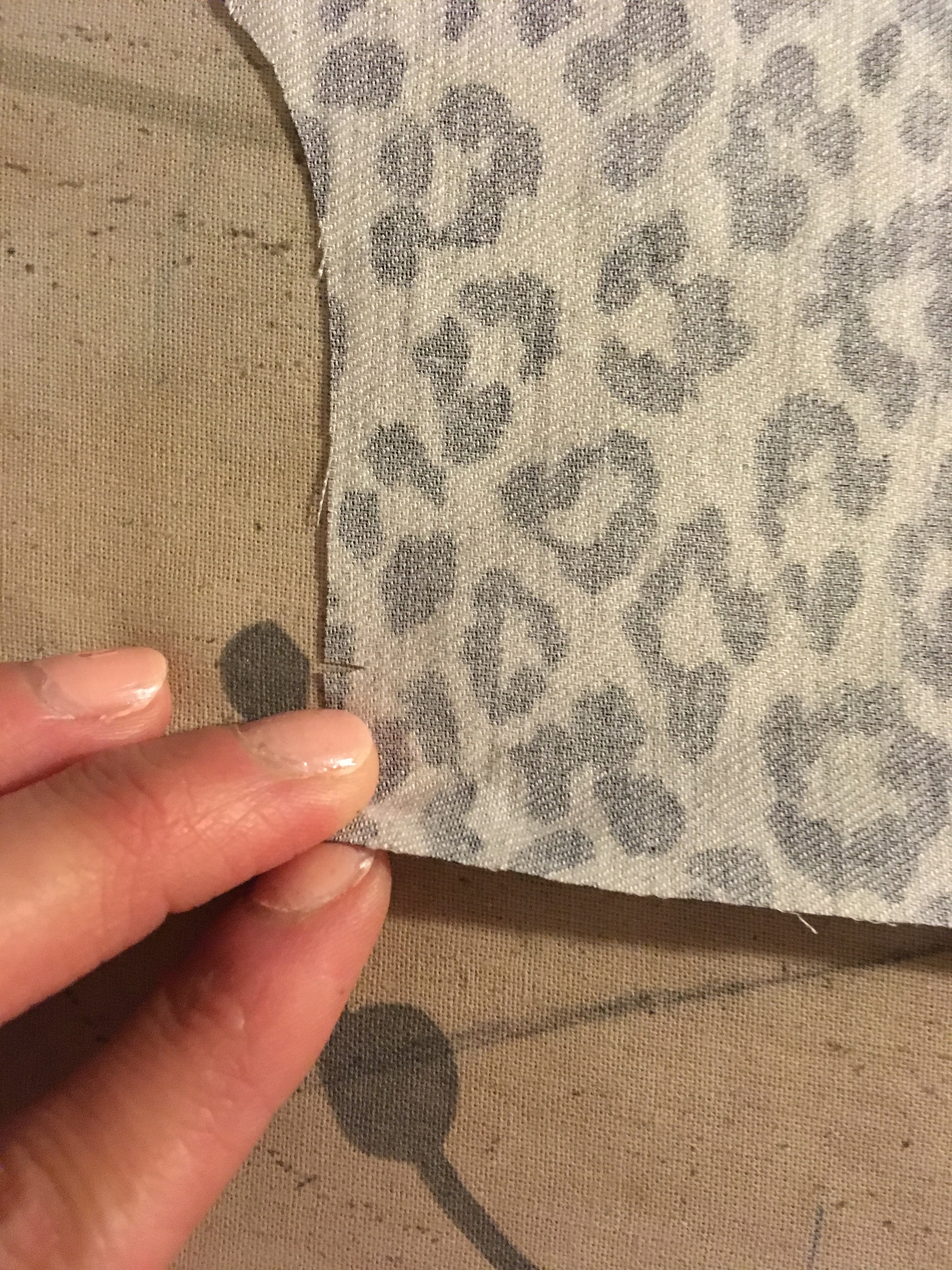

 2nd fold your notch is on the middle back line
2nd fold your notch is on the middle back line  Sew your darts
Sew your darts  For the back I chose not to fold but to absorb the excess fabric by gathering: we change the bobbin thread, we widen the stitch and we release the thread tension, we stitch, we pull the bobbin thread and we gather. we distribute its gathers by pinning its back yokes right side against right side.
For the back I chose not to fold but to absorb the excess fabric by gathering: we change the bobbin thread, we widen the stitch and we release the thread tension, we stitch, we pull the bobbin thread and we gather. we distribute its gathers by pinning its back yokes right side against right side. 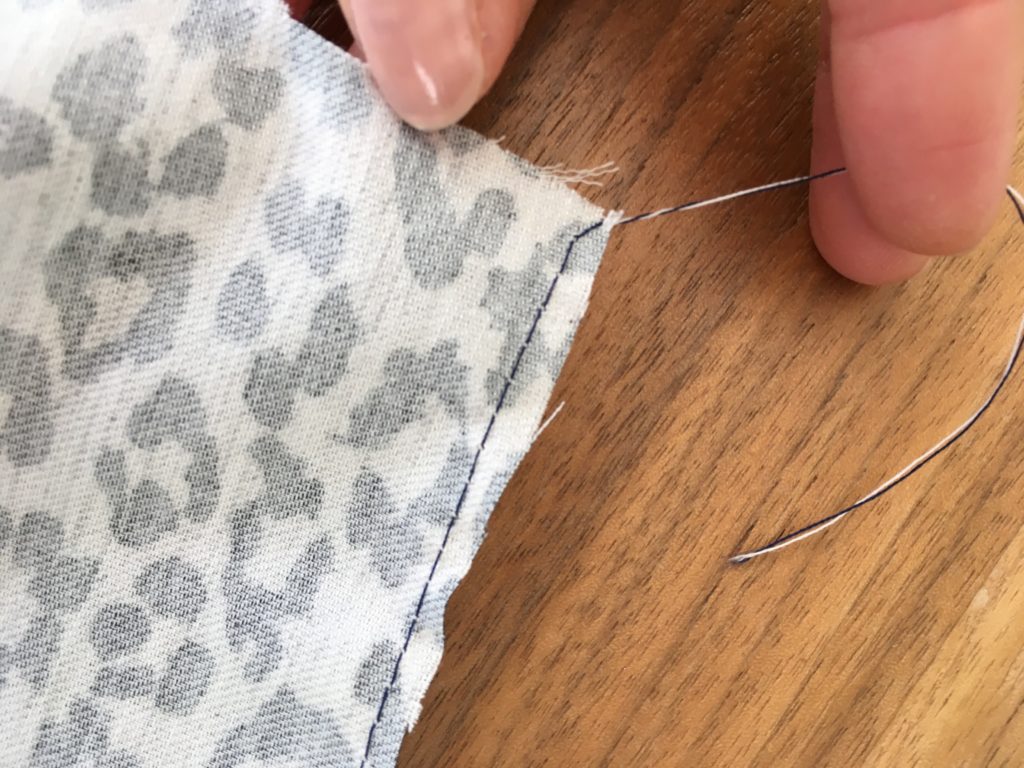


 Press the seam down with an iron. Pin your front and back together at the shoulders, right sides together, sew
Press the seam down with an iron. Pin your front and back together at the shoulders, right sides together, sew  Assembly of the collar good it is clearly your concern with Dahlia, this assembly will be exactly the same for the classic collar so enjoy! pin the 1st collar foot right side against right side over the entire neckline, NTION YOUR COLLAR PIECE CURVATION IS REVERSED IN RELATION TO THE CURVATION OF THE NECKLINE IT IS BY PINNING THAT YOU COME TO MANIPULATE TO ASSEMBLE. And when we turn it over it is impeccable!
Assembly of the collar good it is clearly your concern with Dahlia, this assembly will be exactly the same for the classic collar so enjoy! pin the 1st collar foot right side against right side over the entire neckline, NTION YOUR COLLAR PIECE CURVATION IS REVERSED IN RELATION TO THE CURVATION OF THE NECKLINE IT IS BY PINNING THAT YOU COME TO MANIPULATE TO ASSEMBLE. And when we turn it over it is impeccable! 


 you are going to prepare your gathering strip: first small hem on the top of your strip with a mini hem (we fold over 2/3 mm by pressing with the iron and we sew, we fold again following the first stitch and we sew on the right side a visible one and it is very small!), do the same for the sides.
you are going to prepare your gathering strip: first small hem on the top of your strip with a mini hem (we fold over 2/3 mm by pressing with the iron and we sew, we fold again following the first stitch and we sew on the right side a visible one and it is very small!), do the same for the sides. 


 You will come to make your pleats (personally I pinned from the middle, the ends, then I modeled my pleats) we pin right side against right side all the pleats and we fix with a seam in the seam allowance. and now we come to pin the second collar stand which is interfaced (here there is the lavallière so the ends are long!): we pin right side against right side all the top, the sides and we leave the portion at the bottom open.
You will come to make your pleats (personally I pinned from the middle, the ends, then I modeled my pleats) we pin right side against right side all the pleats and we fix with a seam in the seam allowance. and now we come to pin the second collar stand which is interfaced (here there is the lavallière so the ends are long!): we pin right side against right side all the top, the sides and we leave the portion at the bottom open. 

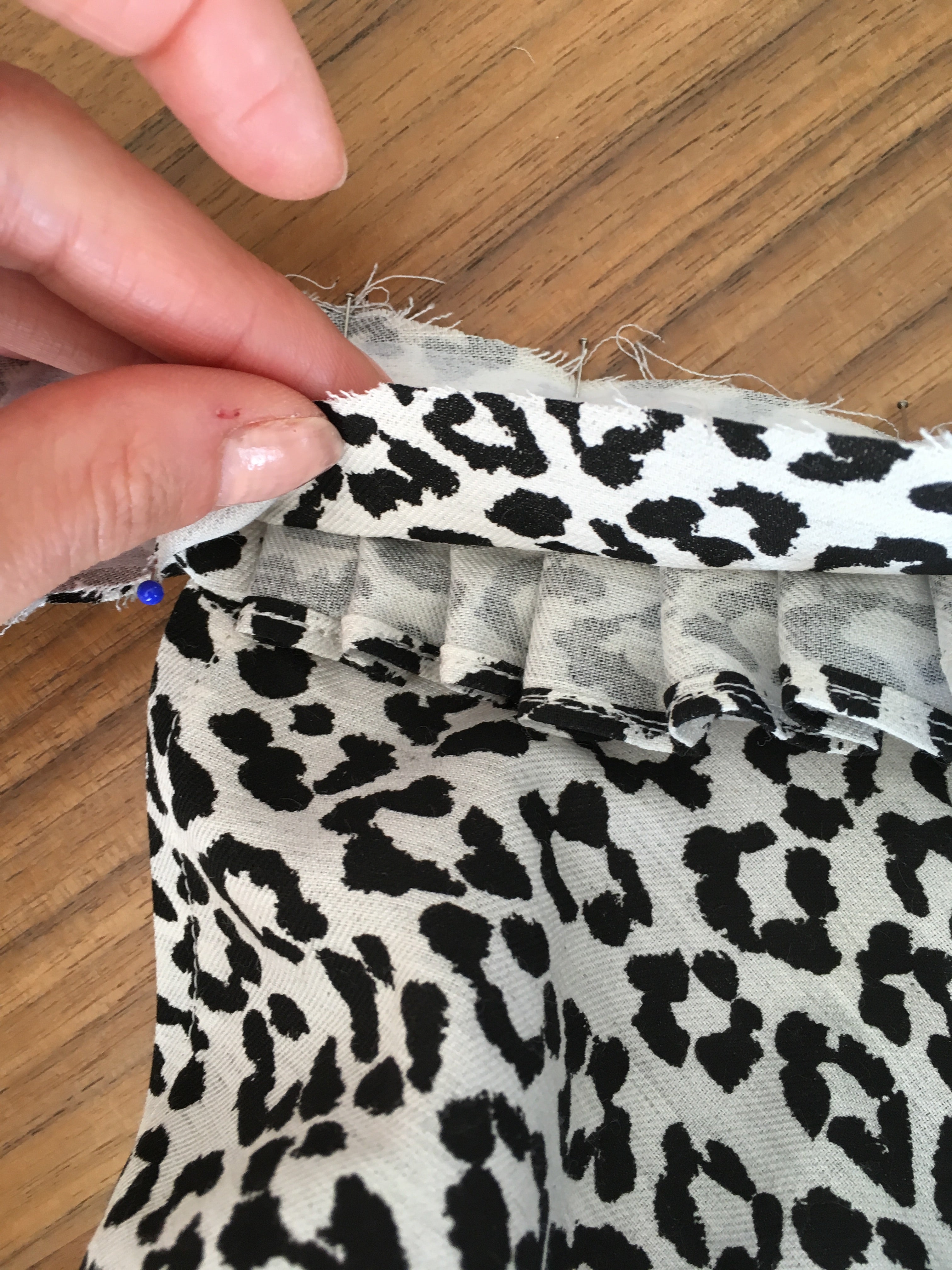
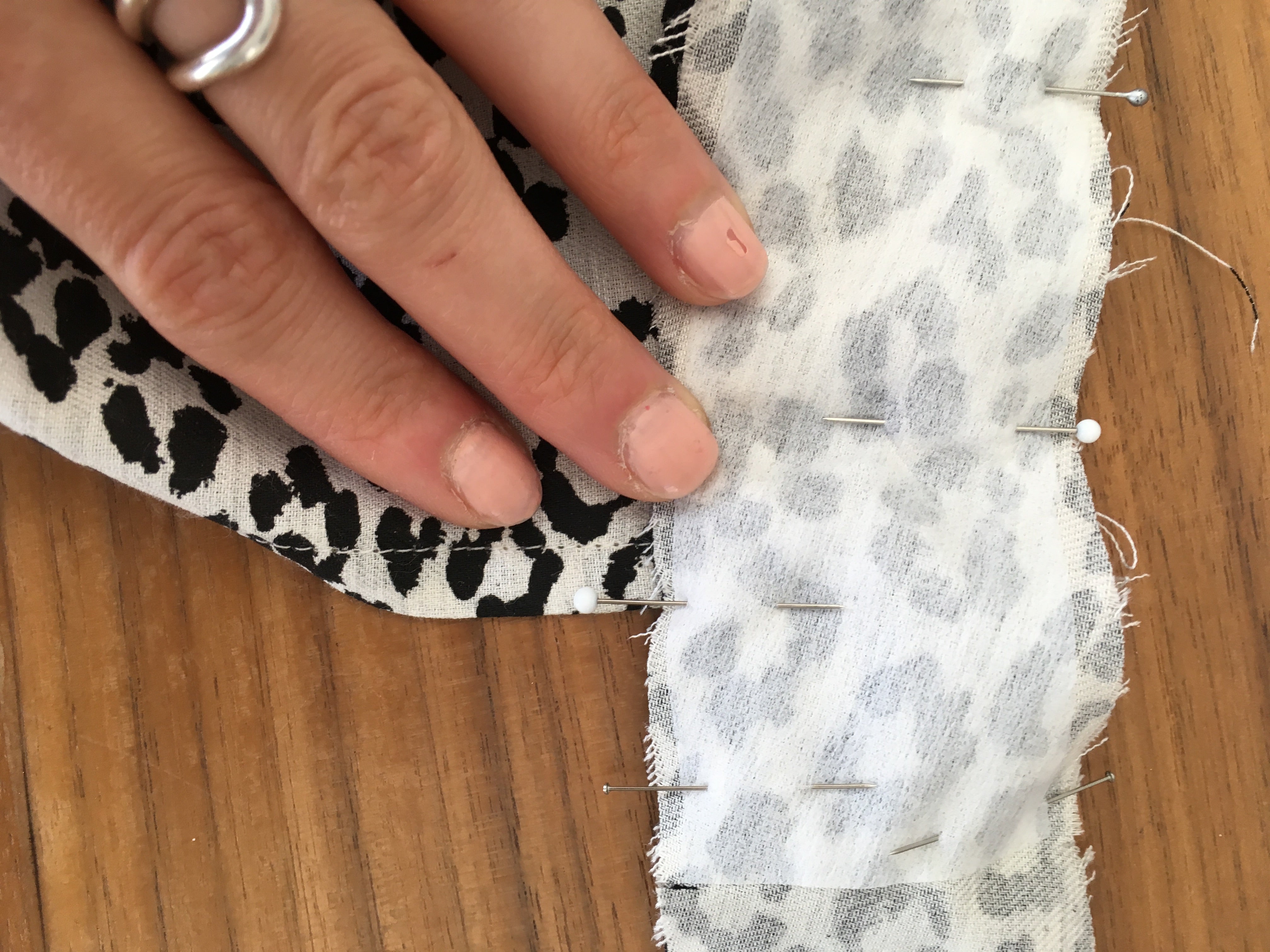
 turn the collar right side out (to help you turn the ascot back use a bias turner, or a chopstick ;) ). All you have to do is fix the portion left open: tuck the seam allowance of the collar stand inside by ironing, and fix with an invisible stitch by hand or a stitch from one end of the collar stand to the other.
turn the collar right side out (to help you turn the ascot back use a bias turner, or a chopstick ;) ). All you have to do is fix the portion left open: tuck the seam allowance of the collar stand inside by ironing, and fix with an invisible stitch by hand or a stitch from one end of the collar stand to the other. 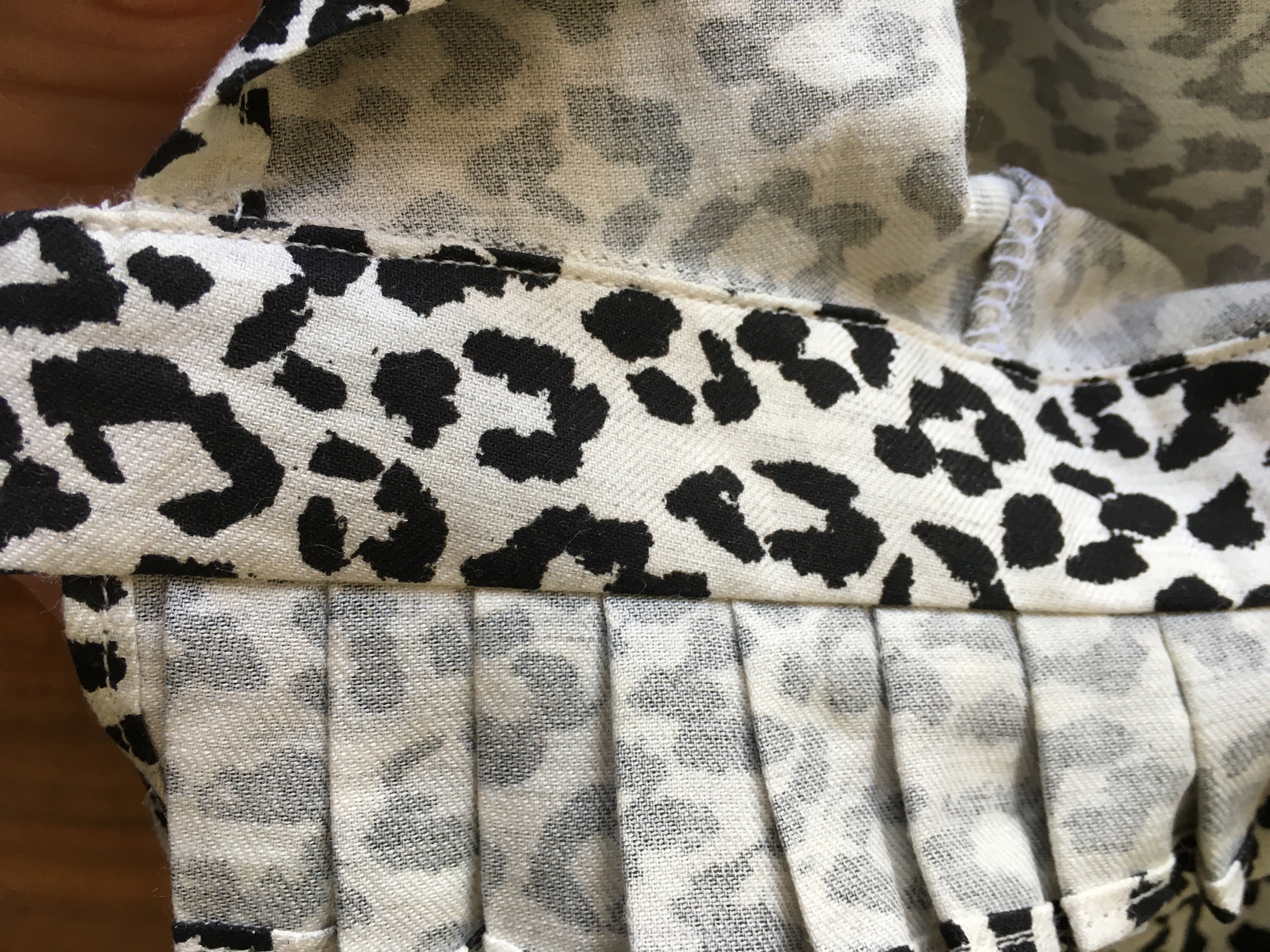
 For the armholes: come and assemble your sides (front and back bust right side against right side, and turn inside out). Finishing armholes with bias: I cut a bias strip in my fabric. Pin right side against right side your bias on your armhole, sew. Put your bias on the right side, and sew together your bias and your seam allowance.
For the armholes: come and assemble your sides (front and back bust right side against right side, and turn inside out). Finishing armholes with bias: I cut a bias strip in my fabric. Pin right side against right side your bias on your armhole, sew. Put your bias on the right side, and sew together your bias and your seam allowance. 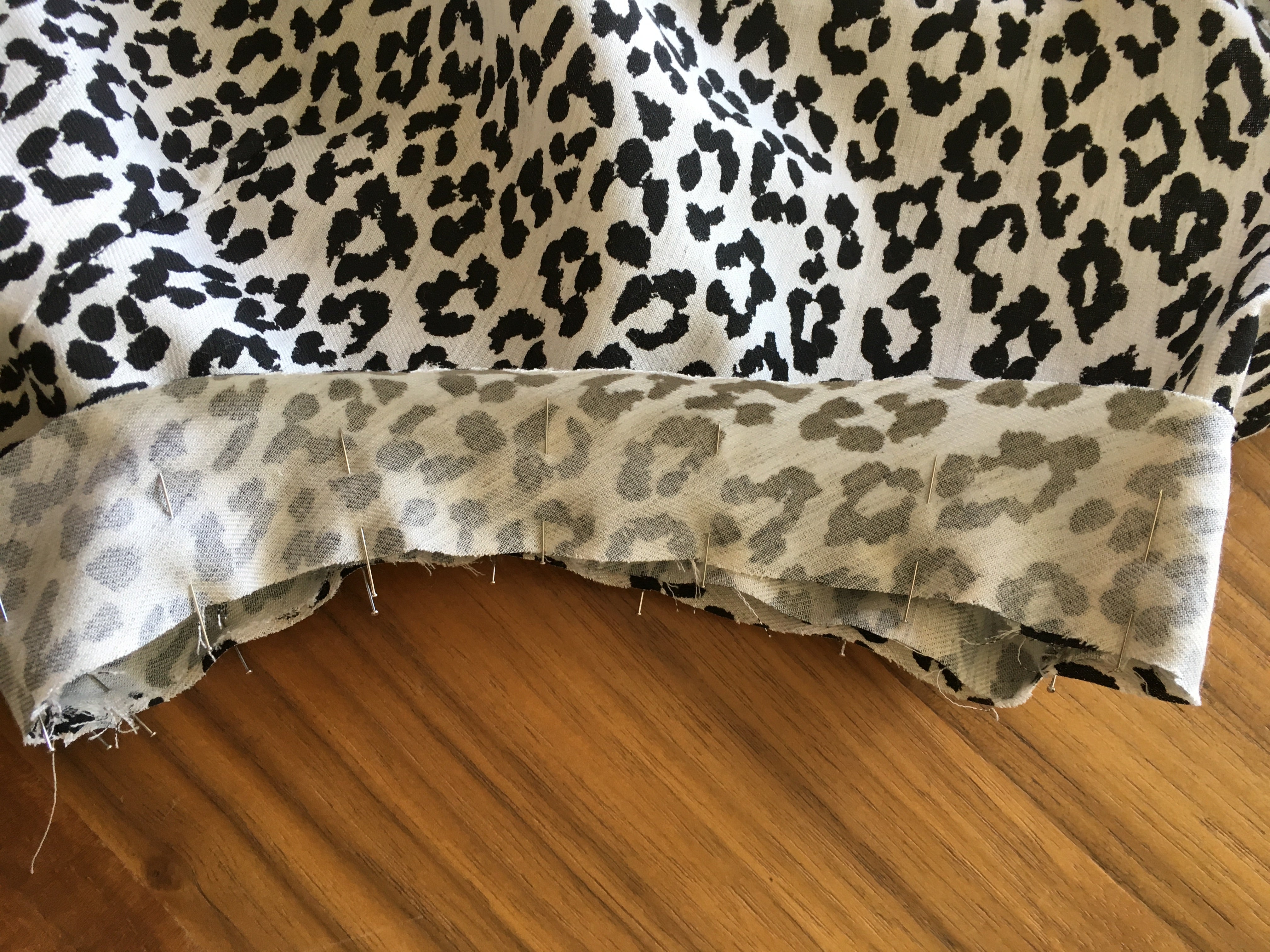


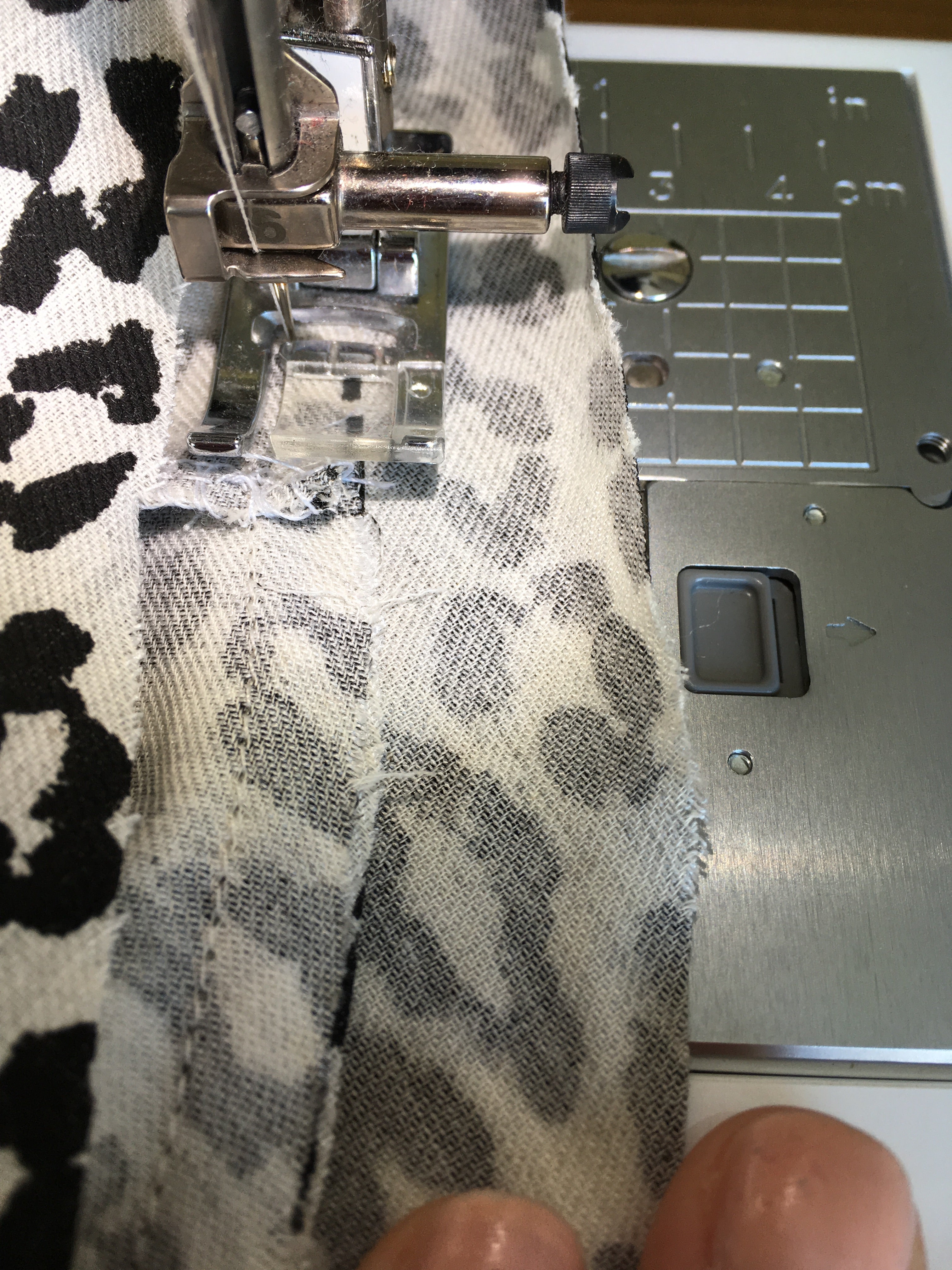

 Then you come and fold your bias from the wrong side following the first seam. Fold twice and sew. Iron well.
Then you come and fold your bias from the wrong side following the first seam. Fold twice and sew. Iron well. 


 Well, do your hem (same technique as for the edge of your gathering strip) and there you have it!!!!
Well, do your hem (same technique as for the edge of your gathering strip) and there you have it!!!! 

 When the Mango publishing house contacted me to write a pattern-making book, I was flattered but also a little terrified. I thought a lot about the angle from which to approach the question. Making pattern-making democratic and fun is really difficult, because the part of building basic patterns remains a very academic step. This is why I chose to highlight the "transformations" that allow you to make your basic pattern BUT ALSO when you want to get started gently, to start from a commercial pattern and personalize it. As an example, I wanted to show you how to transform an "old" pattern from my collections, the Dahlia blouse , to make you a very, very trendy little piece this spring: a pussy-bow blouse WITH a ruffled collar (the double trouble that rocks!). And as the heat rises towards my place, we skip the sleeves and rework the armholes a little (and yes I make you work but you'll see it's so pretty!). And then with this slightly collared model we would quickly get hot otherwise. For this version I also chose to skip the back pleat and I simply gathered it (crazy go!).
When the Mango publishing house contacted me to write a pattern-making book, I was flattered but also a little terrified. I thought a lot about the angle from which to approach the question. Making pattern-making democratic and fun is really difficult, because the part of building basic patterns remains a very academic step. This is why I chose to highlight the "transformations" that allow you to make your basic pattern BUT ALSO when you want to get started gently, to start from a commercial pattern and personalize it. As an example, I wanted to show you how to transform an "old" pattern from my collections, the Dahlia blouse , to make you a very, very trendy little piece this spring: a pussy-bow blouse WITH a ruffled collar (the double trouble that rocks!). And as the heat rises towards my place, we skip the sleeves and rework the armholes a little (and yes I make you work but you'll see it's so pretty!). And then with this slightly collared model we would quickly get hot otherwise. For this version I also chose to skip the back pleat and I simply gathered it (crazy go!). 
 The fabric comes from the brand new online haberdashery Folkandfabric . This is the 3rd fabric I've sewn from them and it's still wonderful! The print is crazy and the slightly "raw" look of the fabric (you'll see it in the close-up) takes the drama out of the animal skin. And then, French fabric, it's still a pleasure. I hope you'll like my blouse as much as I do, personally I'm crazy about it! The tie can be tied in the front, at the back, or gently used as a tie, it's up to you!
The fabric comes from the brand new online haberdashery Folkandfabric . This is the 3rd fabric I've sewn from them and it's still wonderful! The print is crazy and the slightly "raw" look of the fabric (you'll see it in the close-up) takes the drama out of the animal skin. And then, French fabric, it's still a pleasure. I hope you'll like my blouse as much as I do, personally I'm crazy about it! The tie can be tied in the front, at the back, or gently used as a tie, it's up to you! 

 Come on, let's go for the tutorial of this transformed Dahlia: I started by retouching the pattern: I shortened the front and back shoulder line by 4 cm to cut out the armholes (it's up to you, of course I wanted to cut out the armholes), and I re-traced with a gun (for the back I pinned the yoke and the bottom of the back, be careful when taping to overlap the seam allowance). And I extended my collar stand piece by 55 cm (the piece being on the fold you will have a nice lavallière, and you have to cut it x2 on the fold ;) )
Come on, let's go for the tutorial of this transformed Dahlia: I started by retouching the pattern: I shortened the front and back shoulder line by 4 cm to cut out the armholes (it's up to you, of course I wanted to cut out the armholes), and I re-traced with a gun (for the back I pinned the yoke and the bottom of the back, be careful when taping to overlap the seam allowance). And I extended my collar stand piece by 55 cm (the piece being on the fold you will have a nice lavallière, and you have to cut it x2 on the fold ;) ) 


 Back assembly: fold your center back line of the back yoke twice to make the small center back hem (your assembly notch prefigures the "finished" garment, i.e. the hem made).
Back assembly: fold your center back line of the back yoke twice to make the small center back hem (your assembly notch prefigures the "finished" garment, i.e. the hem made). 

 2nd fold your notch is on the middle back line
2nd fold your notch is on the middle back line  Sew your darts
Sew your darts  For the back I chose not to fold but to absorb the excess fabric by gathering: we change the bobbin thread, we widen the stitch and we release the thread tension, we stitch, we pull the bobbin thread and we gather. we distribute its gathers by pinning its back yokes right side against right side.
For the back I chose not to fold but to absorb the excess fabric by gathering: we change the bobbin thread, we widen the stitch and we release the thread tension, we stitch, we pull the bobbin thread and we gather. we distribute its gathers by pinning its back yokes right side against right side. 


 Press the seam down with an iron. Pin your front and back together at the shoulders, right sides together, sew
Press the seam down with an iron. Pin your front and back together at the shoulders, right sides together, sew  Assembly of the collar good it is clearly your concern with Dahlia, this assembly will be exactly the same for the classic collar so enjoy! pin the 1st collar foot right side against right side over the entire neckline, NTION YOUR COLLAR PIECE CURVATION IS REVERSED IN RELATION TO THE CURVATION OF THE NECKLINE IT IS BY PINNING THAT YOU COME TO MANIPULATE TO ASSEMBLE. And when we turn it over it is impeccable!
Assembly of the collar good it is clearly your concern with Dahlia, this assembly will be exactly the same for the classic collar so enjoy! pin the 1st collar foot right side against right side over the entire neckline, NTION YOUR COLLAR PIECE CURVATION IS REVERSED IN RELATION TO THE CURVATION OF THE NECKLINE IT IS BY PINNING THAT YOU COME TO MANIPULATE TO ASSEMBLE. And when we turn it over it is impeccable! 


 you are going to prepare your gathering strip: first small hem on the top of your strip with a mini hem (we fold over 2/3 mm by pressing with the iron and we sew, we fold again following the first stitch and we sew on the right side a visible one and it is very small!), do the same for the sides.
you are going to prepare your gathering strip: first small hem on the top of your strip with a mini hem (we fold over 2/3 mm by pressing with the iron and we sew, we fold again following the first stitch and we sew on the right side a visible one and it is very small!), do the same for the sides. 


 You will come to make your pleats (personally I pinned from the middle, the ends, then I modeled my pleats) we pin right side against right side all the pleats and we fix with a seam in the seam allowance. and now we come to pin the second collar stand which is interfaced (here there is the lavallière so the ends are long!): we pin right side against right side all the top, the sides and we leave the portion at the bottom open.
You will come to make your pleats (personally I pinned from the middle, the ends, then I modeled my pleats) we pin right side against right side all the pleats and we fix with a seam in the seam allowance. and now we come to pin the second collar stand which is interfaced (here there is the lavallière so the ends are long!): we pin right side against right side all the top, the sides and we leave the portion at the bottom open. 



 turn the collar right side out (to help you turn the ascot back use a bias turner, or a chopstick ;) ). All you have to do is fix the portion left open: tuck the seam allowance of the collar stand inside by ironing, and fix with an invisible stitch by hand or a stitch from one end of the collar stand to the other.
turn the collar right side out (to help you turn the ascot back use a bias turner, or a chopstick ;) ). All you have to do is fix the portion left open: tuck the seam allowance of the collar stand inside by ironing, and fix with an invisible stitch by hand or a stitch from one end of the collar stand to the other. 
 For the armholes: come and assemble your sides (front and back bust right side against right side, and turn inside out). Finishing armholes with bias: I cut a bias strip in my fabric. Pin right side against right side your bias on your armhole, sew. Put your bias on the right side, and sew together your bias and your seam allowance.
For the armholes: come and assemble your sides (front and back bust right side against right side, and turn inside out). Finishing armholes with bias: I cut a bias strip in my fabric. Pin right side against right side your bias on your armhole, sew. Put your bias on the right side, and sew together your bias and your seam allowance. 




 Then you come and fold your bias from the wrong side following the first seam. Fold twice and sew. Iron well.
Then you come and fold your bias from the wrong side following the first seam. Fold twice and sew. Iron well. 


 Well, do your hem (same technique as for the edge of your gathering strip) and there you have it!!!!
Well, do your hem (same technique as for the edge of your gathering strip) and there you have it!!!! 

















